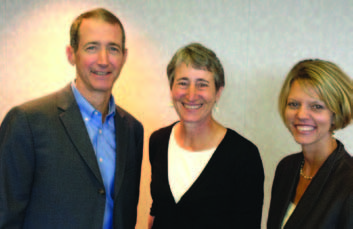In late August the boards and staff of RDC and the Alaska Oil and Gas Association (AOGA) had the opportunity to meet with the new Environmental Protection Agency (EPA) administrator Gina McCarthy. McCarthy was recently confirmed by the U.S. Senate to take the helm of the agency following the departure of Lisa Jackson. The overwhelming attendance by RDC and AOGA board members at this meeting illustrates the huge role the EPA plays in Alaska affairs.
The EPA issues permits for air emissions and also oversees the state’s water program to ensure it complies with the Federal clean water act mandates. While the U.S. Army Corps of Engineers issues permits for dredge and fill on wetlands under section 404 of the Clean Water Act, the EPA has the authority under section 404(c) to prohibit, deny, or restrict the use of any defined area as a disposal site. EPA enforces Clean Water Act Section 404 provisions. Because Alaska has an estimated 130 million acres of wetlands, about one-third of the state, 404 permits are required for most activities, everything from developing resource projects like a large mine, drilling for oil, or fish processing. Permits are also required for public works like building roads, pipelines, schools, and even homes.
In our meeting, AOGA and RDC engaged McCarthy on leading EPA related issues facing Alaska. We expressed our concerns and perspective on many issues including: the EPA’s use of its 404(c) authority to retroactively revoke permits as they have demonstrated a willingness to do at a West Virginia coal mine; the threat that EPA may veto projects before they have been fully vetted through the normal permitting process (Pebble); the one-size-fits-all approach to air requirements that results in absurd outcomes in Alaska like having to fly waste out by helicopter from remote sites; the EPA’s view of the future of coal given the President’s recent remarks on climate change; and the EPA’s plans to increase agency efficiency, given the budget pressures of sequestration.
McCarthy traveled to Dillingham and Iliamna to hear diverse views on the Pebble project. Under the leadership of her predecessor Lisa Jackson, the EPA launched an unprecedented watershed assessment covering an area the size of West Virginia, with the stated intent “to understand how large-scale mining could potentially affect water quality and salmon ecosystems in the Bristol Bay watershed.” Never mind that there are no permit applications for a mine, and when one is submitted it will trigger a multi-year exhaustive public process and scientific scrutiny that will determine whether a mine can be developed without significant harm to fisheries resources and the environment. Jackson refused invitations to visit the project or meet with local residents supportive of it. To McCarthy’s credit, she’s jumping right in to go see for herself what’s at stake.
McCarthy impressed me as a good listener; pragmatic and driven by science and data more than public opinion and politics. This is encouraging. McCarthy’s willingness to visit Alaska and hear diverse views from Alaskans, including RDC, and to get out to rural Alaska and see Pebble for herself can only help her in her new challenging role in leading the EPA. Her openness to diverse Alaskan views suggests relations with EPA may improve.
But walking the talk and steering an agency with 17,000 employees across 10 regional offices to be less political and more science based and pragmatic is a tall order. Of course, what really matters is action. Will we see a more reasoned and tempered agency driven more by science than politics? Will McCarthy steer the EPA back to a neutral objective science-based organization that respects the time tested permitting process? Will EPA abandon a one-sizefits- all approach and recognize remote Alaska often requires unique approaches?
Or perhaps will EPA continue to march forward and squash Alaska sovereignty; preemptively prohibiting uses in Southwest Alaska on close to 10% of Alaska’s Statehood entitlement land absent a formal project plan complete with measures mitigating adverse impacts?
I’m hopeful we notice some substantive change in EPA. I’m grateful the Administrator took the time to hear from RDC and our colleagues at AOGA. Improved communication is an important first step to more rationale outcomes.
•••••••••••••••••••••••••••••••••••••

In addition to meeting with EPA Administrator Gina McCarthy in August, the Board of Directors of the Alaska Oil and Gas Association and RDC met with Interior Secretary Sally Jewell in Anchorage September 3rd. RDC’s Rick Rogers and AOGA’s Kara Moriarty led the discussion with Jewell, pictured at center.
Return to newsletter headlines